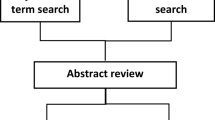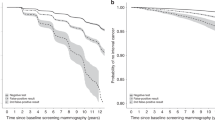Abstract
Screening for early detection of breast cancer is considered to be an important element of preventive medicine. In this paper, we use numerical simulations to examine the length bias in regular interval screening programmes, by computing the doubling times of breast cancer tumours detected through regular mammographies compared to self-detection. Our analysis shows that doubling times of tumours detected by a regular screening programme are longer than doubling times in the original whole population and considerably longer than those self-detected. Hence regular interval mammographies may be missing a high proportion of fast growing tumours and therefore the benefits of current screening programmes may need to be re-evaluated. We examine the likely size of the length bias for the present UK breast cancer screening programme and perform a sensitivity analysis by varying the screen detection probabilities to reflect future advances in mammographic detection.









Similar content being viewed by others
References
Yankaskas BC, Kalbunde CN, Ancelle-Park R, Renner G, Wang H, Fracheboud J et al (2004) International comparison of performance measures for screening mammography: can it be done? J Med Screen 11:187–193
Robinson D, Bell J, Møller H, Salman A (2006) A 13-year follow-up of patients with breast cancer presenting to a district general hospital breast unit in south-east England. Breast 15:173–180
Bundred NJ (2007) Bs22 prognostic index in screen-detected breast cancer. ANZ J Surg 77:A5–A6
Hellquist BN, Duffy SW, Abdsaleh S, Bjorneld L et al (2010) Effectiveness of population-based service screening with mammography for women ages 40 to 49 years. Cancer. doi:10.1002/cncr.25650
Gates TJ (2001) Cancer screening in perspective. Am Fam Physician 63(6):1039–1040, 1042
Gøtzsche PC, Olsen O (2000) Is screening for breast cancer with mammography justifiable? Lancet 355:129–134
Olsen O, Gøtzsche PC (2001) Cochrane review on screening for breast cancer with mammography. Lancet 358:1340–1342
Horton R (2002) Screening mammography: setting the record straight. Lancet 359:441–442
Gabe R, Duffy SW (2005) Evaluation of service screening mammography in practice: the impact on breast cancer mortality. Ann Oncol 16(Supplement 2):153–162
Roder DM, Houssami N, Farshid G et al (2008) Population screening and intensity of screening are associated with reduced breast cancer mortality: evidence of efficacy of mammography screening in Australia. Breast Cancer Res Treat 8:409–416
McPherson K (2010) Screening for breast cancer—balancing the debate. BMJ 340:c3106
Office for National Statistics (2010) Breast cancer incidence http://www.statistics.gov.uk/cci/nugget.asp?id=575. Accessed 15th October 2010
American Cancer Society (2010) Cancer facts and figures 2007. http://www.cancer.org/acs/groups/content/@nho/documents/document/caff2007pwsecuredpdf.pdf. Accessed on 15th October 2010
Knox EG (1973) A simulation system for screening procedures. In: McLachlan G (ed) Future and present indicatives, problems and progress in medical care. Nuffield Provincial Hospitals Trust, pp 17–55
Boer R, Plevritis S, Clarke L (2004) Diversity of model approaches for breast cancer screening: a review of model assumptions by (CISNET) breast cancer groups. Stat Meth Med Res 13:525–538
Habbema JD, van Oortmarssen GJ, Lubbe JT, van der Maas PJ (1985) The MISCAN simulation program for the evaluation of screening for disease. Comput Meth Programs Biomed 20:79–93
Boer R, de Koning H, Threlfall A, Warmerdam P, Street A, Freidman E, Woodman C (1998) Cost effectiveness of shortening screening interval or extending age range of NHS breast screening programme: computer simulation study. British Medical Journal 317:376–379
Szeto KL, Devlin NJ (1996) The cost-effectiveness of mammography screening: evidence from a microsimulation model for New Zealand. Health Policy 38:101–115
Jansen JT, Zoetelief J (1997) Optimisation of mammographic breast cancer screening using a computer simulation model. Eur J Radiol 24(2):137–144
Feuer EJ (2006) Modeling the impact of adjuvant therapy and screening mammography on U.S. breast cancer mortality between 1975 and 2000: introduction to the problem. J Natl Cancer Inst Monogr 36:2–6
Clarke LD, Plevritis SK, Boer R, Cronin KA, Feuer EJ (2006) A comparative review of CISNET breast models used to analyze U.S. breast cancer incidence and mortality trends. J Natl Cancer Inst Monogr 36:96–105
Kerr GR (1978) Data on tumour sizes. Report by the Department of Clinical Oncology, Edinburgh, UK
Kusama S, Spratt JS, Donegan WL, Watson FR, Cunningham C (1972) The gross rates of growth of human mammary carcinoma. Cancer 30:594–599
Zorin AV, Edler L, Hanin LG, Yakovlev AY (2005) Estimating the natural history of breast cancer from bivariate data on age and tumor size at diagnosis. In: Edle L, Kitsos CP (eds) Recent advances in quantitative methods for cancer and human health risk assessment. Wiley, New York, pp 317–327
Spratt JA, Vonfournier D, Spratt JS, Weber EE (1993) Decelerating growth and human breast cancer. Cancer 71:2013–2019
Office of Population Censuses and Surveys (1981) Cancer statistics: registrations. HMSO, London
Michaelson J, Satija S, Moore R, Griffin G, Halpern E, Garland A, Kopans DB, Hughes K (2003) Estimates of the sizes at which breast cancers become detectable on mammographic and clinical grounds. J Wom Imag 5(1):3–10
Klemi PJ, Joensuu H, Toikkanen S, Tuominen J, Rasanen O, Tyrkko J, Parvinen I (1992) Aggressiveness of breast cancers found with and without screening. Br Med J 304:467–469
Author information
Authors and Affiliations
Corresponding author
Rights and permissions
About this article
Cite this article
Vieira, I.T., de Senna, V., Harper, P.R. et al. Tumour doubling times and the length bias in breast cancer screening programmes. Health Care Manag Sci 14, 203–211 (2011). https://doi.org/10.1007/s10729-011-9156-9
Received:
Accepted:
Published:
Issue Date:
DOI: https://doi.org/10.1007/s10729-011-9156-9




